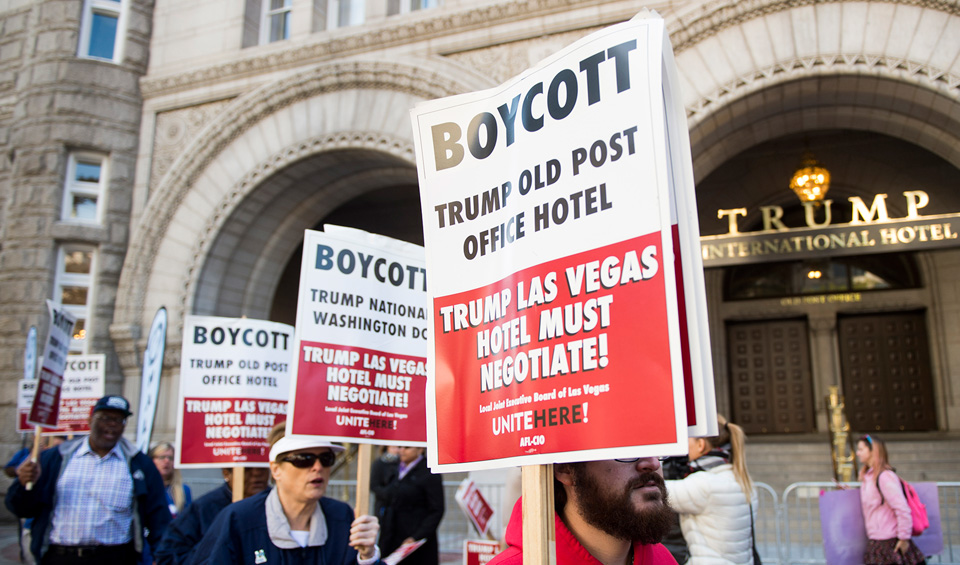
WASHINGTON – For progressive activists, the loudest wake-up call in many years blared this past Election Day: Donald Trump was elected president because a perfect storm with numerous causes blew strong and hard that day.
It is of particular concern to labor, which backed Hillary Clinton, that they lost the support of a significant number of white workers in depressed areas of the rust belt states.
It is not lost on American unions that the areas in which they lost workers to Trump are areas where the labor movement itself has suffered a severe decline, one that parallels the decline of the industrial economy.
Many factors, of course, contributed to Clinton’s loss: the existence of the Electoral College; the fact that due to institutionalized voter suppression there were some 900 less polling places than there were in 2012, the Clinton campaign not putting enough resources into winning states such as Iowa and Georgia, dirty tricks by FBI Director James Comey and Trump’s exploitation of the Clinton e-mail issue. One can go on and on but there is no point.
Even if Clinton had won, worker advocates and union activists are saying they would have to be be launching campaigns to unite white workers in the rust belt with other workers of all races and nationalities around the country. Last week, presidents of AFL-CIO unions met here for two days and, with that in mind, began to map strategies for bringing these workers back into movements that, unlike Trump, are fighting for their real interests.
They will need the backing of progressive activists around the country and of a media that is not yet publicizing their crusade. It’s where the labor and independent press, including the Peoples World, become more important than ever.
Many Trump voters in Pennsylvania, Ohio, Wisconsin, Indiana and Michigan are men and women who lost their jobs when industrial plants shut down. Those now working have jobs that pay a lot less and do not offer security for working families. These folks are not moving elsewhere.
Despite changing demographics across the nation, white working-class voters remain the largest single voting block in many states that any candidate for president must win.
Their support, along with the support of workers of all races and ethnic groups, is key to progressive movements aimed at building a more equitable and just nation.
Progressive ideal
Progressive activists have always fought for a society in which all workers – including workers like those who voted for Donald Trump – would have a right to a good job and a fair share of the wealth they help produce.
In the 1930s, this ideal was a major weapon in the effort to organize into unions the grandparents and great grandparents of the workers who voted for Trump. For union organizers, this ideal was key in overcoming the racism and xenophobia that had kept workers apart for generations.
However, little by little, big corporations and their political representatives worked to undermine collective bargaining in industrial states and since the 1970s, workers there have been slipping away from both the union movement and the Democratic Party.
Finally, this year over 60 percent of white workers voted for Donald Trump, even though many were concerned about his qualifications for the job and even though many didn’t endorse his behavior towards or his statements about women.
According to the AFL-CIO, Trump voters included 37 percent of all union members and one half of members of union households in battleground states.
How do unions explain that vote then? “More than anything,” said AFL-CIO President Richard Trumka, “this election is an indictment of politics as usual. For too long, the political elites have embraced economic policies that hold down wages, increase inequality, diminish opportunity and ship American jobs overseas.
“Voters in both the primary and general election have delivered a clear message: Enough.”
Misogyny?
Observers across the country are asking if white workers voted for Trump because of the hate that fueled his campaign, or if, perhaps, they voted for him despite his hateful rhetoric.
The answer, of course, is some Trump supporters were swayed by his anti-immigrant, anti-black, anti-Latino, sexist diatribes and some were not.
Most have two things in common: they voted for Trump because they want “change” and they considered Clinton part of the “establishment” that has abandoned them.
Joan C. Williams, a prominent feminist legal scholar, writes in her paper, What so many people don’t get about the U.S. working class, “The election shows that sexism retains a deeper hold that most imagined. But women don’t stand together: white working class women voted for Trump over Clinton by a whopping 28 point margin – 62 to 34 percent …
“Class trumps gender,” Williams concluded.
Activists working to knock down misogyny as a barrier to bringing workers together take hope in the fact that voters across the country have elected women to governorships, the U.S. House and the Senate. In fact, two of the states Clinton lost have women governors. Also, voters in seven states that went for Trump nevertheless send women to the U.S. Senate.
Racism?
There have been untold examples of Trump supporters who have spewed in public his racist, xenophobic and bigoted rhetoric.
In addition, “Economic resentment,” Williams says, “has fueled racial anxiety that, in some Trump supporters (and Trump himself), bleeds into open racism. But to write off white working class anger as nothing more than racism is intellectual comfort food, and it is dangerous.”
After all, many of those who voted for Donald Trump had voted for Barrack Obama just four years ago and in even larger numbers eight years earlier.
Alec MacGillis writes in ProPublica that “cause for resentment and letdown had grown in many of those Rust Belt communities where Obama had held his own — they might be inching their way back from the Great Recession, but the progress [is] awfully slow, and they [are] lagging ever further behind booming coastal cities like New York, San Francisco and Washington …”.
Needed: a union comeback
According to the New School for Social Research, “When workers were in unions alongside others who had different color skin, holding together a viable multiracial working class coalition was possible.
“But unions have been destroyed [in the rust belt states] … and stunning economic decline has made it easy for narratives of zero-sum competition between different social groups to take hold.”
Union presidents meeting after the Clinton defeat were well aware of the truth of the findings of the New School: Trump was able to fill the vacuum remaining in the rust belt after the influence of unions was forcibly smashed.
The first step toward union rebirth, said Stuart Appelbaum, president of the UFCW-affiliated Retail, Wholesale and Department Store union, , is “to begin discussions on how to reach our own people.”
This has begun.
Also, unions will work to become integral parts of communities, whether or not there are many union members in them. “This is how unions began to organize in the first place,” said Harold Meyerson, a nationally known columnist.
This effort was begun three years ago, when the AFL-CIO launched Working America. Today it has over some three million non-union members.
Among many other activities, Working America canvassers hold “front porch conversations” in communities where there are high concentrations of Trump supporters, often introducing them to a “countervailing pull of a progressive vision for the future.”
Unions are not starting from scratch in rust belt communities. There are still large numbers of workers in them who bucked the majority and voted for Clinton.
Also, unions can help direct the “anti-establishment” feelings that are being expressed by millions of workers. For example, it could take leadership of the movement to get big money out of politics. A June New York Times/CBS News poll showed that 84 percent of Democrats and 81 percent of Republicans want to fundamentally change or completely rebuild our campaign finance system.
In fact, many Trump voters say they supported him because “he’s so rich he, can’t be bought off.”
Trump put together a winning multi-economic-class coalition. He gained the support of right wingers by truthfully assuring them he will strengthen anti-worker policies that have been making the already wealthy even richer. He gained the support of the very same workers who have been the victims of these policies by lying to them about the causes of the conditions that have robbed them of high paying jobs and economic security and by saying that he and he alone, can and will “fix things.”
At first, many Republicans didn’t get what Trump was up to and distanced themselves from him. By now, with the exception of Ohio Governor John Kasich, there are no active Republican leaders who have not jumped on the Trump bandwagon, even if they continue to criticize him.
Trump ran against Wall Street bankers and brokers rhetorically, while in reality courting them and, in the end, winning them over. He’s now appointing hedge fund bigshots to his transition team and Cabinet.
The labor movement, with the support of publications like People’s World, will be continuously calling Trump out for the lies he continuously tells.
And the labor movement will be there to fill the vacuum left by Trump when workers catch on to the fact that have been snookered by a billionaire con artist who has spent his entire career ripping off people just like those who voted for him.
As President Trumka says, “Our beliefs should not be dependent on who is in office. Fairness, dignity and equality are things we’ve always fought for. Therefore, the work of the labor movement continues with fresh urgency.










